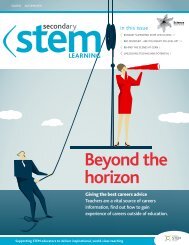Create successful ePaper yourself
Turn your PDF publications into a flip-book with our unique Google optimized e-Paper software.
4. No triangles; the sum of angles is greater<br />
than 180°.<br />
5. Exactly one triangle; SSS<br />
6. Exactly one triangle; SAS<br />
7. Exactly two triangles; SSA<br />
8. Exactly one triangle;ASA<br />
9. Exactly one triangle; SAA<br />
10. No triangles; SSSA—too many constraints<br />
Discussion Answers<br />
A. See Notes and Answers above.<br />
B. See Notes and Answers above. SSS, SAS, and<br />
ASA are criteria for congruence of triangles.<br />
So is SAA, which is essentially a version of<br />
ASA, because once two angles are determined,<br />
the third is too.<br />
C. See Notes and Answers above.<br />
D. Problem 7<br />
Lab 6.2: Walking Parallelograms<br />
This is an opportunity to review the angles<br />
created when a transversal cuts two parallel lines,<br />
while getting started on the general classification<br />
of quadrilaterals. Students often are confused<br />
about “Is a square a rectangle, or is a rectangle<br />
a square”This lesson provides one way to get<br />
some clarity on this or at least provides an<br />
additional arena for discussion. See Lab 5.2<br />
(Triangle and Quadrilateral Symmetry) for a<br />
complementary approach.<br />
Students could be paired up, with each member<br />
of the pair executing the instructions written by<br />
the other member.The values of the variables<br />
must be stated before starting the walk.<br />
In Problem 5, note that a variable should NOT<br />
be used in the case of the angles of the square<br />
and rectangle, since they are always 90°.<br />
For Problems 9 and 10, you may give the hint<br />
that there are five true statements of the type<br />
“a rhombus is a parallelogram” that apply to<br />
the four quadrilaterals discussed.<br />
To summarize, you may explain how a tree<br />
diagram or a Venn diagram can be used<br />
to display the relationships between the<br />
four figures.<br />
Rhombi<br />
Rhombi<br />
Quadrilaterals<br />
Parallelograms<br />
Squares<br />
Quadrilaterals<br />
Parallelograms<br />
Squares<br />
Rectangles<br />
Rectangles<br />
Question F is a way to follow up on a discussion<br />
about hierarchical relationships among<br />
quadrilaterals, rather than a direct extension of<br />
the lab.The answer to the question “Is a<br />
parallelogram a trapezoid” depends on how a<br />
trapezoid is defined.<br />
Answers<br />
1. The first two turns add to 180°, since you’re<br />
facing opposite to your original position.<br />
2. Turn right 40°;<br />
Walk forward one step;<br />
Turn right 140°;<br />
Walk forward three steps;<br />
Turn right 40°.<br />
3. 40° and 140°<br />
4. Do this twice:<br />
Walk forward x steps;<br />
Turn right a°;<br />
Walk forward y steps;<br />
Turn right (180 a)°.<br />
200 Notes and Answers Geometry Labs<br />
© 1999 Henri Picciotto, www.MathEducationPage.org






